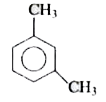Which one of the following nitrates will leaves behind a metal on strong heating?
Copper nitrate
Manganese nitrate
Silver nitrate
Ferric nitrate
The correct Answer is:3
To determine which nitrate will leave behind a metal upon strong heating, we will analyze the thermal decomposition reactions of each of the given nitrates: copper nitrate, manganese nitrate, silver nitrate, and ferric nitrate.
1. Copper Nitrate (Cu(NO3)2):
- When copper nitrate is strongly heated, it decomposes as follows:
2Cu(NO3)2→2CuO+4NO2+O2
- The products are copper oxide (CuO), nitrogen dioxide (NO2), and oxygen (O2). No elemental copper metal is produced.
2. Manganese Nitrate (Mn(NO3)2):
- The thermal decomposition of manganese nitrate is represented by:
2Mn(NO3)2→2MnO+4NO2+O2
- Here, manganese oxide (MnO) is formed along with nitrogen dioxide and oxygen. Again, no elemental manganese metal is produced.
3. Silver Nitrate (AgNO3):
- The reaction for silver nitrate upon strong heating is:
2AgNO3→2Ag+2NO2+O2
- This decomposition yields silver metal (Ag), nitrogen dioxide, and oxygen. This indicates that silver nitrate does leave behind a metal upon heating.
4. Ferric Nitrate (Fe(NO3)3):
- The decomposition of ferric nitrate can be represented as:
2Fe(NO3)3→Fe2O3+6NO2+3O2
- The products include ferric oxide (Fe2O3), nitrogen dioxide, and oxygen. No elemental iron is produced.
Conclusion:
Among the nitrates analyzed, silver nitrate (AgNO3) is the only compound that leaves behind a metal (silver) upon strong heating.
Final Answer:
Silver Nitrate (AgNO3)
---
- When copper nitrate is strongly heated, it decomposes as follows:
2Cu(NO3)2→2CuO+4NO2+O2
- The products are copper oxide (CuO), nitrogen dioxide (NO2), and oxygen (O2). No elemental copper metal is produced.
- The thermal decomposition of manganese nitrate is represented by:
2Mn(NO3)2→2MnO+4NO2+O2
- Here, manganese oxide (MnO) is formed along with nitrogen dioxide and oxygen. Again, no elemental manganese metal is produced.
- The reaction for silver nitrate upon strong heating is:
2AgNO3→2Ag+2NO2+O2
- This decomposition yields silver metal (Ag), nitrogen dioxide, and oxygen. This indicates that silver nitrate does leave behind a metal upon heating.
- The decomposition of ferric nitrate can be represented as:
2Fe(NO3)3→Fe2O3+6NO2+3O2
- The products include ferric oxide (Fe2O3), nitrogen dioxide, and oxygen. No elemental iron is produced.
Among the nitrates analyzed, silver nitrate (AgNO3) is the only compound that leaves behind a metal (silver) upon strong heating.
Silver Nitrate (AgNO3)
Topper's Solved these Questions
- BOOK - RESONANCE ENGLISHCHAPTER - D BLOCK ELEMENTSEXERCISE - EXERCISE-3 PART-III37videos
D BLOCK ELEMENTS
- BOOK - RESONANCE ENGLISHCHAPTER - D BLOCK ELEMENTSEXERCISE - EXERCISE-3 PART-I15videos
D BLOCK ELEMENTS
- BOOK - RESONANCE ENGLISHCHAPTER - D & F BLOCK ELEMENTSEXERCISE - ORGANIC CHEMISTRY(Aldehydes , Ketones, Carboxylic acid)15videos
D & F BLOCK ELEMENTS
- BOOK - RESONANCE ENGLISHCHAPTER - DPPEXERCISE - QUESTIONS368videos
DPP
Similar Questions
Knowledge Check
- Question 1 - Select One
Which one of the following is an alkali metal?
Aa)MgBb)AlCc)KDd)Kr - Question 2 - Select One
Which one of the following is a strong acid?
ACH3COOHBHClCH2C2O4DH2CO3 - Question 3 - Select One
Which one of the following compounds give only one isomer upon nitration ?
A B
B C
C D
D
Which one of the following has the largest floating leaves
View SolutionWhich one of the following alkali metals is the most metallic?
View SolutionWhich of the following carbonates do not give metal oxide on heating ?
View SolutionWhich one converts nitrite to nitrate?
View SolutionWhich of the following metal carbonates is decomposed on heating?
View Solution

